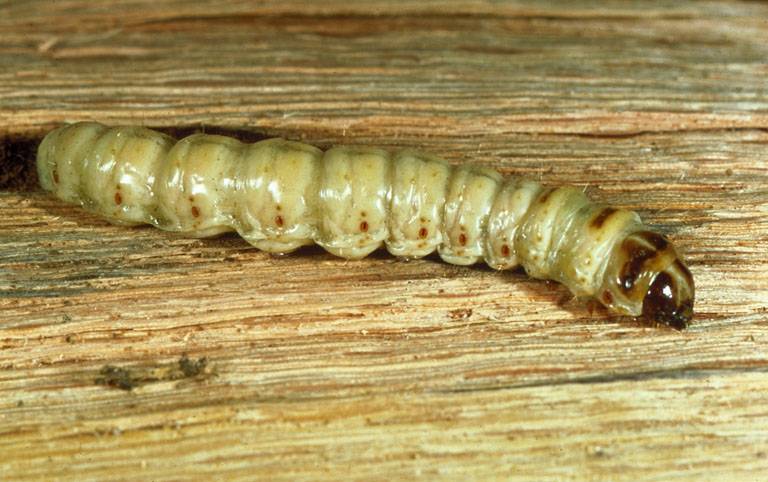Integrated Pest Management
Carpenterworm Moth
 Adult carpenterworm moth (James Solomon, USDA Forest Service, Bugwood.org)
Adult carpenterworm moth (James Solomon, USDA Forest Service, Bugwood.org)
 Carpenterworm larvae (William H. Hoffard, USDA Forest Service, Bugwood.org)
Carpenterworm larvae (William H. Hoffard, USDA Forest Service, Bugwood.org)
 Bark damage from carpenterworm larvae (Bob Hammon, Colorado State University, Bugwood.org)
Bark damage from carpenterworm larvae (Bob Hammon, Colorado State University, Bugwood.org)
HOSTS
- Black Locust
- Cottonwood
- Elm
- Green Ash
- Maple
- Lilac
- Oak
- Pear
- Poplar
- Willow
DESCRIPTION
Adult carpenterworms are large, heavy-bodied, mottled gray moths. The females have a wingspread of about 3 inches with light gray hindwings. Males are about 2/3 the size of the females and have yellowish-orange hindwings. The larval stage of the carpenterworm, Prionoxystus robiniae is a wood-boring insect that affects various ornamental trees.
BIOLOGY
Adults begin emerging from host trees in late May or early June, are most numerous in mid to late June, and complete emergence by mid-July. Individual adults live for about one week. Females deposit 200 or more olive green, oblong eggs, singly or in masses, in bark crevices, under lichens or moss, or near wounds
Egg hatch occurs within 14 days. The 1/4 inch long, reddish-pink larvae penetrate the tree within a few hours, either through the bark or through existing holes. When development is completed, the pupae wriggle to the mouth of the burrow and the adults emerge, leaving the empty pupal case protruding from the burrow entrance.
SYMPTOMS
- Frass plug at burrow entrance
- Discolored and moist areas around injured tissues
- Dead sections of bark that may eventually separate and fall off
- Presence of empty pupal cases
GENERAL MANAGEMENT
Stressed or low vigor trees are more likely to become infested. Cultural techniques that improve or maintain the vigor of a tree will reduce the potential for damage. Heavily infested, weak, or cull trees are probably best removed. Avoid bark injuries that may invite the entry of carpenterworms or other borers. Larvae produce large, relatively straight tunnels, the entrances of which are marked with expelled frass. As a result, light infestations can be controlled by probing the tunnels with a piece of wire until the larvae are punctured.
INSECTICIDES
Insecticides may be applied as preventative treatments to the trunk and larger limbs of shade trees during the period of adult activity. These applications will kill newly-hatched larvae as they attempt to penetrate the bark.
Carpenterworm larvae are difficult to control once they are within the tree. Injected insecticides may provide some control of larvae. Injections of insect attacking nematodes (Steinernema carpocapsae) into carpenterworm tunnels have been shown to be somewhat effective in controlling the larvae.
Homeowner-type insecticides labeled for borer control (bark treatments) on ornamental trees include some formulations of carbaryl and permethrin. Additional formulations containing bifenthrin, carbaryl, cyhalothrin, cypermethrin, lambdacyhalothrin, and permethrin are available for professional use.

